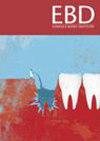系统评估SLA®与SLActive®种植体表面在12周内的稳定性。
IF 2.3
Q3 Dentistry
引用次数: 0
摘要
目的:本研究旨在评估两种种植体表面SLA和SLActive对种植体稳定性的影响,通过12周的ISQ水平来测量。方法:全面检索截至2023年2月的MEDLINE、EMBASE、Cochrane Central Register of Controlled Trials和dental and Oral Sciences数据库中的随机对照试验(RCTs)。纳入标准是涉及使用SLA和SLActive植入物治疗的成年患者的研究,通过植入后12周的ISQ水平评估植入物的稳定性。结果:从最初确定的180篇潜在符合条件的出版物中,我们的分析纳入了6项随机对照试验,包括326种植入物(50.6% SLA和49.4% SLActive)。三项研究被归为低风险,另外三项研究的偏倚风险不明确。总体而言,根据ISQ测量,SLActive种植体在上颌或下颌区域种植体的12周间隔内表现出与SLA种植体相当的稳定性水平。然而,随机对照试验的结果表明,与放置在腭区的SLA表面相比,SLActive表面在12周结束时导致了更早的过渡点,更快地恢复到稳定水平,并且ISQ值更高。结论:SLActive表面在上颌和下颌种植体中具有与SLA表面相似的稳定性。值得注意的是,对于腭种植体,SLActive在12周时可以实现更快的过渡点和更高的稳定性。由于试验数量有限和潜在的研究异质性,需要进一步的研究来验证这些发现。本文章由计算机程序翻译,如有差异,请以英文原文为准。

A systematic assessment of the stability of SLA® vs. SLActive® implant surfaces over 12 weeks
This study aims to assess the impact of two implant surfaces, SLA and SLActive, on implant stability, measured by ISQ levels over a 12-week period. A comprehensive search of MEDLINE, EMBASE, Cochrane Central Register of Controlled Trials, and Dentistry and Oral Sciences databases for randomized controlled trials (RCTs) up to February 2023 was conducted. The inclusion criteria were studies involving adult patients treated with SLA and SLActive implants, with assessment of implant stability through ISQ levels up to 12 weeks post-placement. From the initial 180 potentially eligible publications identified, six RCTs were included in our analysis, comprising 326 implants (50.6% SLA and 49.4% SLActive). Three studies were classified as low risk, while three had an unclear risk of bias. Overall, SLActive implants demonstrated comparable stability levels, as measured by ISQ, to SLA implants within the 12-week interval for implants placed in the maxillary or mandibular region. However, findings from the RCTs suggest that the SLActive surface led to an earlier transition point, a faster return to stability levels, and higher ISQ values at the end of 12 weeks compared to the SLA surface for implants placed in the palatal region. SLActive surfaces exhibited stability levels similar to SLA surfaces for maxillary and mandibular implants. Notably, for palatal implants, SLActive resulted in a quicker transition point and higher stability levels at the 12-week mark. Due to the limited number of trials and potential study heterogeneity, further research is needed to validate these findings.
求助全文
通过发布文献求助,成功后即可免费获取论文全文。
去求助
来源期刊

Evidence-based dentistry
Dentistry-Dentistry (all)
CiteScore
2.50
自引率
0.00%
发文量
77
期刊介绍:
Evidence-Based Dentistry delivers the best available evidence on the latest developments in oral health. We evaluate the evidence and provide guidance concerning the value of the author''s conclusions. We keep dentistry up to date with new approaches, exploring a wide range of the latest developments through an accessible expert commentary. Original papers and relevant publications are condensed into digestible summaries, drawing attention to the current methods and findings. We are a central resource for the most cutting edge and relevant issues concerning the evidence-based approach in dentistry today. Evidence-Based Dentistry is published by Springer Nature on behalf of the British Dental Association.
 求助内容:
求助内容: 应助结果提醒方式:
应助结果提醒方式:


